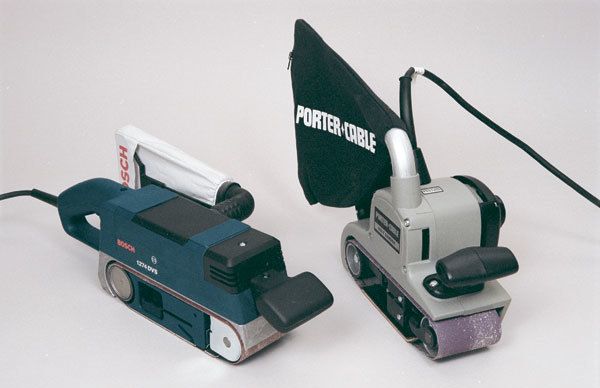What's the Difference: Belt sanders
Finish sanding is one thing, but if you're looking to remove lots of stock in a short amount of time, you'll need a belt sander

In-line or transverse?
I like my random-orbit sander. It sands big, flat surfaces faster than an orbital sander. But even the best random-orbit sander is just a pumped-up finish sander. When it comes to removing lots of stock fast, belt sanders leave random-orbiters in the dust.
Belt sanders quickly snuff out high spots on a subfloor, erase mill marks from baseboard and flatten joinery on shop-built doors. Belt sanders scribe trim and countertops. Mounted in an optional stand or clamped upside down on a work surface, they’ll sharpen a chisel or fine-tune a miter.
Sanding belts normally measure 3 in. or 4 in. wide and 21 in. or 24 in. in circumference. The belts fit over a rear-drive roller and a freewheeling front roller and ride over a fixed platen that forms a flat, rigid sanding surface. Unless you plan to sand broad, horizontal surfaces all day, a 3-incher is all you need. Smaller sanders weigh less, use less expensive belts and are more versatile.
If you do choose a 3-incher, you can go with one of two types: transverse or in-line machines (photo left). Transverse sanders, which are the industry standard, have motors mounted perpendicular to the length of the tool. In-line sanders, which are made by Bosch (800-815-8665), Porter-Cable (800-487-8665) and Ryobi (800-525-2579), have motors parallel to the length of the tool. Transverse sanders tend to be at least an inch wider than equivalent in-line sanders, which reduces clearance in tight quarters. Also, the center of gravity on transverse sanders leans toward the drive train on the left side of the tool (relative to the operator). You have to twist the sanders clockwise while sanding to compensate. In-line sanders require little or no compensation, which can improve accuracy while also saving your wrists for fly fishing.
Some builders prefer the top-mounted rear handles on transverse sanders because the handles permit easier one-handed sanding (which I rarely do). I think the wide handle spacing on in-line sanders works well for two-handed sanding and is more comfortable for scribing.
If you plan to sand overhead or vertically, you’ll appreciate the featherweight 3×21 Bosch 1274DVS or the Ryobi BE321 in-line sander, each of which weighs less than 8 lb. But if you normally work on the horizontal and want to obliterate stock fast, take a look at Porter-Cable’s super-aggressive 3×24 in-line model 504 (or 503, which includes a dust port and bag). It weighs more than 15 lb. but features silky-smooth, durable worm gearing; a 40-year track record; and the countenance of a locomotive.
A couple of choices
In-line sanders, such as the Bosch on the left, are narrower and better balanced than standard transverse sanders (right), such as the Porter-Cable.
Fine Homebuilding Recommended Products
Fine Homebuilding receives a commission for items purchased through links on this site, including Amazon Associates and other affiliate advertising programs.

8067 All-Weather Flashing Tape

Affordable IR Camera

Reliable Crimp Connectors






















